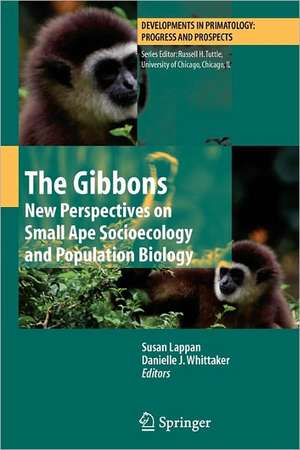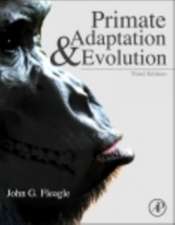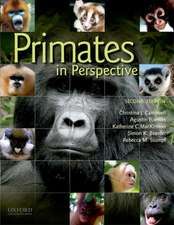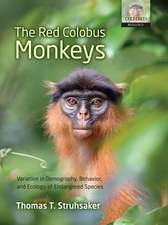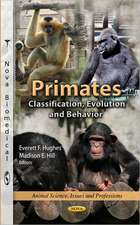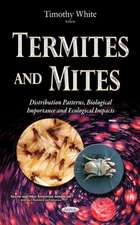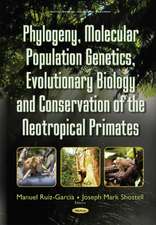The Gibbons: New Perspectives on Small Ape Socioecology and Population Biology: Developments in Primatology: Progress and Prospects
Editat de Susan Lappan, Danielle Whittakeren Limba Engleză Paperback – 6 dec 2010
| Toate formatele și edițiile | Preț | Express |
|---|---|---|
| Paperback (1) | 1827.48 lei 43-57 zile | |
| Springer – 6 dec 2010 | 1827.48 lei 43-57 zile | |
| Hardback (1) | 1833.78 lei 43-57 zile | |
| Springer – 16 iun 2009 | 1833.78 lei 43-57 zile |
Din seria Developments in Primatology: Progress and Prospects
- 20%
 Preț: 571.31 lei
Preț: 571.31 lei - 18%
 Preț: 1216.65 lei
Preț: 1216.65 lei - 19%
 Preț: 578.66 lei
Preț: 578.66 lei - 18%
 Preț: 956.69 lei
Preț: 956.69 lei - 18%
 Preț: 948.92 lei
Preț: 948.92 lei - 18%
 Preț: 948.92 lei
Preț: 948.92 lei - 18%
 Preț: 945.79 lei
Preț: 945.79 lei - 18%
 Preț: 962.66 lei
Preț: 962.66 lei - 18%
 Preț: 1664.43 lei
Preț: 1664.43 lei - 18%
 Preț: 1224.54 lei
Preț: 1224.54 lei - 24%
 Preț: 826.25 lei
Preț: 826.25 lei - 24%
 Preț: 802.74 lei
Preț: 802.74 lei - 18%
 Preț: 1562.94 lei
Preț: 1562.94 lei - 18%
 Preț: 950.21 lei
Preț: 950.21 lei - 18%
 Preț: 943.73 lei
Preț: 943.73 lei - 18%
 Preț: 1549.67 lei
Preț: 1549.67 lei - 18%
 Preț: 1248.20 lei
Preț: 1248.20 lei - 18%
 Preț: 941.38 lei
Preț: 941.38 lei - 24%
 Preț: 800.85 lei
Preț: 800.85 lei - 18%
 Preț: 953.35 lei
Preț: 953.35 lei - 18%
 Preț: 1214.90 lei
Preț: 1214.90 lei - 18%
 Preț: 957.62 lei
Preț: 957.62 lei - 18%
 Preț: 1231.47 lei
Preț: 1231.47 lei - 18%
 Preț: 1225.48 lei
Preț: 1225.48 lei - 5%
 Preț: 1433.83 lei
Preț: 1433.83 lei - 18%
 Preț: 1231.16 lei
Preț: 1231.16 lei - 18%
 Preț: 1226.90 lei
Preț: 1226.90 lei - 18%
 Preț: 955.25 lei
Preț: 955.25 lei - 18%
 Preț: 956.03 lei
Preț: 956.03 lei - 18%
 Preț: 1218.53 lei
Preț: 1218.53 lei - 18%
 Preț: 950.52 lei
Preț: 950.52 lei -
 Preț: 416.82 lei
Preț: 416.82 lei - 18%
 Preț: 1554.89 lei
Preț: 1554.89 lei
Preț: 1827.48 lei
Preț vechi: 2228.64 lei
-18% Nou
Puncte Express: 2741
Preț estimativ în valută:
349.69€ • 366.03$ • 291.05£
349.69€ • 366.03$ • 291.05£
Carte tipărită la comandă
Livrare economică 31 martie-14 aprilie
Preluare comenzi: 021 569.72.76
Specificații
ISBN-13: 9781441927828
ISBN-10: 1441927824
Pagini: 544
Ilustrații: XVIII, 526 p. 87 illus.
Dimensiuni: 155 x 235 x 29 mm
Greutate: 0.75 kg
Ediția:Softcover reprint of hardcover 1st ed. 2009
Editura: Springer
Colecția Springer
Seria Developments in Primatology: Progress and Prospects
Locul publicării:New York, NY, United States
ISBN-10: 1441927824
Pagini: 544
Ilustrații: XVIII, 526 p. 87 illus.
Dimensiuni: 155 x 235 x 29 mm
Greutate: 0.75 kg
Ediția:Softcover reprint of hardcover 1st ed. 2009
Editura: Springer
Colecția Springer
Seria Developments in Primatology: Progress and Prospects
Locul publicării:New York, NY, United States
Public țintă
ResearchCuprins
The Diversity of Small Apes and the Importance of Population-Level Studies.- Biogeography.- Evolutionary Relationships Among the Gibbons: A Biogeographic Perspective.- Genetic Differentiation of Agile Gibbons Between Sumatra and Kalimantan in Indonesia.- Vocal Diversity of Kloss’s Gibbons (Hylobates Klossii) in the Mentawai Islands, Indonesia.- Phylogeography of Kloss’s Gibbon (Hylobates Klossii) Populations and Implications for Conservation Planning in the Mentawai Islands.- Individual and Geographical Variability in the Songs of Wild Silvery Gibbons (Hylobates Moloch) on Java, Indonesia.- The Fossil Record of Gibbons.- Diet and Community Ecology.- Hylobatid Diets Revisited: The Importance of Body Mass, Fruit Availability, and Interspecific Competition.- Competition and Niche Overlap Between Gibbons (Hylobates albibarbis) and Other Frugivorous Vertebrates in Gunung Palung National Park, West Kalimantan, Indonesia.- The Seed Dispersal Niche of Gibbons in Bornean Dipterocarp Forests.- The Relationship Between Ecology and Social Organization.- Ecology and the Social System of Gibbons.- The Ecology and Evolution of Hylobatid Communities: Causal and Contextual Factors Underlying Inter- and Intraspecific Variation.- Seasonal Home Range Use and Defendability in White-Handed Gibbons (Hylobates lar) in Khao Yai National Park, Thailand.- Mating Systems and Reproduction.- Monogamy in Mammals: Expanding the Perspective on Hylobatid Mating Systems.- Monitoring Female Reproductive Status in White-Handed Gibbons (Hylobates lar) Using Fecal Hormone Analysis and Patterns of Genital Skin Swellings.- Patterns of Infant Care in Wild Siamangs (Symphalangus syndactylus) in Southern Sumatra.- The Social Organization and Mating System of Khao Yai White-Handed Gibbons: 1992-2006.-Conservation Biology.- Status and Conservation of Yellow-Cheeked Crested Gibbons (Nomascus gabriellae) in the Seima Biodiversity Conservation Area, Mondulkiri Province, Cambodia.- The Distribution and Abundance of Hoolock Gibbons in India.- Census of Eastern Hoolock Gibbons (Hoolock leuconedys) in Mahamyaing Wildlife Sanctuary, Sagaing Division, Myanmar.- The Population Distribution and Abundance of Siamangs (Symphalangus syndactylus) and Agile Gibbons (Hylobates agilis) in West Central Sumatra, Indonesia.- Canopy Bridges: An Effective Conservation Tactic for Supporting Gibbon Populations in Forest Fragments.- The Role of Reintroduction in Gibbon Conservation: Opportunities and Challenges.- Saving the Small Apes: Conservation Assessment of Gibbon Species at the 2006 Asian Primate Red List Workshop.
Recenzii
From the reviews:
“This volume is based on symposia held in 2002 and 2004, which focused on aspects of gibbon behavior, ecology, conservation, and biogeography, plus analyses of their fossil record and interspecific evolutionary relationships. … it is wonderful to see the range of colleagues from countries ‘hosting’ gibbons, fully engaged in their study. Summing Up: Recommended. Academic audiences, upper-division undergraduates and above.” (E. Delson, Choice, Vol. 47 (3), November, 2009)
“This well-written and insightful edited volume is based on symposia from the 2002 and 2004 International Primatological Society Congresses. Its editors accurately argue that gibbons have not received as much attention as great apes. … By providing the most up-to-date review of hylobatid biogeography, dietary ecology, social organization, and conservation, this volume does an outstanding job in significantly adding to our knowledge of small apes.” (Herbert H. Covert, American Journal of Physical Anthropology, Vol. 143, 2010)
“This volume is based on symposia held in 2002 and 2004, which focused on aspects of gibbon behavior, ecology, conservation, and biogeography, plus analyses of their fossil record and interspecific evolutionary relationships. … it is wonderful to see the range of colleagues from countries ‘hosting’ gibbons, fully engaged in their study. Summing Up: Recommended. Academic audiences, upper-division undergraduates and above.” (E. Delson, Choice, Vol. 47 (3), November, 2009)
“This well-written and insightful edited volume is based on symposia from the 2002 and 2004 International Primatological Society Congresses. Its editors accurately argue that gibbons have not received as much attention as great apes. … By providing the most up-to-date review of hylobatid biogeography, dietary ecology, social organization, and conservation, this volume does an outstanding job in significantly adding to our knowledge of small apes.” (Herbert H. Covert, American Journal of Physical Anthropology, Vol. 143, 2010)
Textul de pe ultima copertă
The small apes, or gibbons, are among our closest living relatives, yet they have received little attention from the scientific community and the public in comparison with the other living apes. This oversight is not due to lack of appeal; their physical beauty, graceful acrobatic movements, and thrilling songs make it clear why gibbons are always among the most popular animals in zoos. Rather, the inherent difficulties involved in studying or filming gibbons in their natural habitats and, in some cases, the misconception that among apes, smaller means lesser, have led many researchers and filmmakers to focus their attentions elsewhere. Nonetheless, a growing number of intrepid field and laboratory researchers have made steady progress in the study of gibbon behavior and ecology over the last several decades. This volume is a systematic compilation of recent research on gibbon socioecology and population biology with a focus on understanding gibbons in the context of their natural habitats, and includes contributions on a range of topics, including gibbon biogeography, the ecological roles played by gibbons in their ecosystems, the origins and functions of key gibbon social and ecological adaptations, and the conservation status of wild gibbon populations.
The contributors address both theoretical questions and the practical implications of our growing knowledge about gibbon adaptations. While gibbons share several important social features with humans, thus providing parallels for understanding human evolution, they are also fascinating creatures in their own right and act as vital components of tropical forest ecosystems. Unfortunately, gibbons are also among the most endangered living apes. This volume should be of interest to researchers and students from a variety of fields, including anthropologists, animal behaviorists, tropical ecologists, evolutionary biologists, and conservation biologists.
The contributors address both theoretical questions and the practical implications of our growing knowledge about gibbon adaptations. While gibbons share several important social features with humans, thus providing parallels for understanding human evolution, they are also fascinating creatures in their own right and act as vital components of tropical forest ecosystems. Unfortunately, gibbons are also among the most endangered living apes. This volume should be of interest to researchers and students from a variety of fields, including anthropologists, animal behaviorists, tropical ecologists, evolutionary biologists, and conservation biologists.
Caracteristici
A reference resource for researchers and students interested in the small apes specifically, as well as researchers interested in the gibbon perspective on a number of theoretical issues in primatology Includes supplementary material: sn.pub/extras
